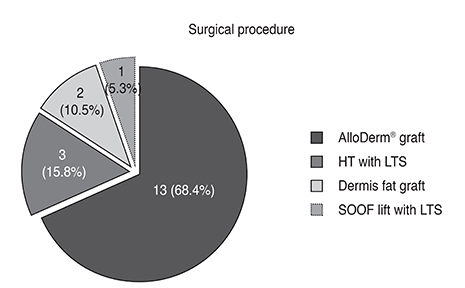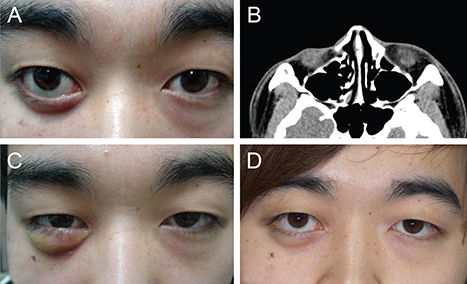Korean J Ophthalmol.
2017 Aug;31(4):290-298. 10.3341/kjo.2016.0059.
Causes and Surgical Outcomes of Lower Eyelid Retraction
- Affiliations
-
- 1Department of Ophthalmology, Kim's Eye Hospital, Myung-Gok Eye Research Institute, Konyang University College of Medicine, Seoul, Korea. jjw@kimeye.com
- 2Hana Eye Clinic, Seoul, Korea.
- 3Hyemin Eye Hospital, Seoul, Korea.
- KMID: 2385577
- DOI: http://doi.org/10.3341/kjo.2016.0059
Abstract
- PURPOSE
To investigate the causes of lower eyelid retraction and evaluate the outcomes of various surgical procedures.
METHODS
We conducted a retrospective medical record review of patients who underwent lower eyelid retraction surgery performed by a single surgeon at Kim's Eye Hospital between 2006 and 2013. We investigated the causes of lower eyelid retraction, clinical history, characteristics, treatment, and surgical outcomes. Preoperative and postoperative margin reflex distance 2 and inferior scleral show were measured for each eyelid. Success was defined as a positive eyelid elevation and a decrease in inferior scleral show.
RESULTS
A total of 19 lower eyelids were treated in 14 patients with lower eyelid retraction. For cosmetic reasons, surgical correction for congenital lower eyelid retraction was performed on seven eyelids (36.8%). Ten eyelids (52.6%) exhibited secondary lower eyelid retraction after surgery. One eyelid (5.3%) was affected by facial palsy and one eyelid (5.3%) exhibited exophthalmos of an unknown origin. We adopted a selective approach based on lower eyelid retraction severity. Spacer grafting via a subconjunctival approach was the most commonly performed surgical technique (13 eyelids, 68.4%). The lateral tarsal strip procedure was used to horizontally tighten three eyelids (15.8%). At the time of the procedure, one of these eyelids (5.3%) also received an adjuvant suborbicularis oculi fat lift. Autogenous dermis fat grafting was performed on two lower eyelids (10.5%), whose retraction was caused by fat and soft tissue loss. Cosmetic outcomes were satisfactory in all cases.
CONCLUSIONS
To achieve satisfactory surgical outcomes, surgeons should adopt an approach based on the severity of lower eyelid retraction. Mild lower eyelid retraction can be corrected without grafts. When retraction is severe and exceeds 2 mm, spacer grafts that push the lower eyelid margin upwards and support it from below are required.
Keyword
MeSH Terms
Figure
Cited by 1 articles
-
Changes in the Horizontal Angular Direction of Lower Eyelashes with Age in Korean Patients
Jungah Huh, Jinhwan Park, Sehyun Baek
J Korean Ophthalmol Soc. 2018;59(2):105-109. doi: 10.3341/jkos.2018.59.2.105.
Reference
-
1. Kersten RC, Kulwin DR, Levartovsky S, et al. Management of lower-lid retraction with hard-palate mucosa grafting. Arch Ophthalmol. 1990; 108:1339–1343.2. Pacheco EM, Guyton DL, Repka MX. Changes in eyelid position accompanying vertical rectus muscle surgery and prevention of lower lid retraction with adjustable surgery. J Pediatr Ophthalmol Strabismus. 1992; 29:265–272.3. McAlister CN, Oestreicher JH. Repeat posterior lamellar grafting for recalcitrant lower eyelid retraction is effective. Orbit. 2012; 31:307–312.4. Wearne MJ, Sandy C, Rose GE, et al. Autogenous hard palate mucosa: the ideal lower eyelid spacer? Br J Ophthalmol. 2001; 85:1183–1187.5. Li TG, Shorr N, Goldberg RA. Comparison of the efficacy of hard palate grafts with acellular human dermis grafts in lower eyelid surgery. Plast Reconstr Surg. 2005; 116:873–878.6. Lee JY. A statistical study on the corneal diameters in Korean. J Korean Ophthalmol Soc. 1983; 24:53–58.7. Collin JR, Allen L, Castronuovo S. Congenital eyelid retraction. Br J Ophthalmol. 1990; 74:542–544.8. Yee RD, Odeh-Nasrala N. Congenital, paradoxical retraction of the lower eyelid. Am J Ophthalmol. 1974; 78:1027–1029.9. Mee JJ, McNab AA. Congenital retraction of the lower eyelid: two case reports. Ophthal Plast Reconstr Surg. 2002; 18:75–78.10. Aggarwal JL. Congenital abnormality of the lower lid. Br J Ophthalmol. 1974; 58:633.11. Holds JB, Anderson RL, Thiese SM. Lower eyelid retraction: a minimal incision surgical approach to retractor lysis. Ophthalmic Surg. 1990; 21:767–771.12. Patipa M. The evaluation and management of lower eyelid retraction following cosmetic surgery. Plast Reconstr Surg. 2000; 106:438–453.13. Yoon C, Kim N, Lee MJ, et al. Correction of lower lid retraction using autologous ear cartilage graft. J Korean Ophthalmol Soc. 2011; 52:136–140.14. Olver JM, Rose GE, Khaw PT, Collin JR. Correction of lower eyelid retraction in thyroid eye disease: a randomised controlled trial of retractor tenotomy with adjuvant antimetabolite versus scleral graft. Br J Ophthalmol. 1998; 82:174–180.15. Shorr N, Perry JD, Goldberg RA, et al. The safety and applications of acellular human dermal allograft in ophthalmic plastic and reconstructive surgery: a preliminary report. Ophthal Plast Reconstr Surg. 2000; 16:223–230.16. Ji JY, Kim YD. Acellular dermal allograft for the correction of eyelid retraction. J Korean Ophthalmol Soc. 2005; 46:1–9.17. Liao SL, Wei YH. Correction of lower lid retraction using tarSys bioengineered grafts for graves ophthalmopathy. Am J Ophthalmol. 2013; 156:387–392.e1.18. Meyer DR, Simon JW, Kansora M. Primary infratarsal lower eyelid retractor lysis to prevent eyelid retraction after inferior rectus muscle recession. Am J Ophthalmol. 1996; 122:331–339.19. Jampolsky A. Management of vertical strabismus. Trans New Orleans Acad Ophthalmol. 1986; 34:141–171.20. Salgarelli AC, Bellini P, Multinu A, et al. Tarsal strip technique for correction of malposition of the lower eyelid after treatment of orbital trauma. Br J Oral Maxillofac Surg. 2009; 47:298–301.21. McGraw BL, Adamson PA. Postblepharoplasty ectropion: prevention and management. Arch Otolaryngol Head Neck Surg. 1991; 117:852–856.22. Edgerton MT Jr. Causes and prevention of lower lid ectropion following blepharoplasty. Plast Reconstr Surg. 1972; 49:367–373.23. Pak J, Putterman AM. Revisional eyelid surgery: treatment of severe postblepharoplasty lower eyelid retraction. Facial Plast Surg Clin North Am. 2005; 13:561–569.24. Holtmann B, Wray RC, Little AG. A randomized comparison of four incisions for orbital fractures. Plast Reconstr Surg. 1981; 67:731–737.25. Zingg M, Chowdhury K, Ladrach K, et al. Treatment of 813 zygoma-lateral orbital complex fractures: new aspects. Arch Otolaryngol Head Neck Surg. 1991; 117:611–620.26. Baylis HI, Long JA, Groth MJ. Transconjunctival lower eyelid blepharoplasty: technique and complications. Ophthalmology. 1989; 96:1027–1032.27. Mommaerts MY, De Riu G. Prevention of lid retraction after lower lid blepharoplasties: an overview. J Craniomaxillofac Surg. 2000; 28:189–200.28. Anderson RL, Gordy DD. The tarsal strip procedure. Arch Ophthalmol. 1979; 97:2192–2196.29. Korn BS, Kikkawa DO, Cohen SR, et al. Treatment of lower eyelid malposition with dermis fat grafting. Ophthalmology. 2008; 115:744–751.e2.30. Smith B, Petrelli R. Dermis-fat graft as a movable implant within the muscle cone. Am J Ophthalmol. 1978; 85:62–66.31. Olver JM. Raising the suborbicularis oculi fat (SOOF): its role in chronic facial palsy. Br J Ophthalmol. 2000; 84:1401–1406.
- Full Text Links
- Actions
-
Cited
- CITED
-
- Close
- Share
- Similar articles
-
- Outcomes of Various Surgical Procedures on Acquired Lower Eyelid Epiblepharon in Thyroid Associated Ophthalmopathy
- Surgical Efficacyin the Upper and Lower Eyelid Retraction
- Lower Eyelid Epiblepharon Associated with Lower Eyelid Retraction
- Acellular Dermal Allograft for the Correction of Eyelid Retraction
- Etiology of Eyelid Retraction in Koreans





